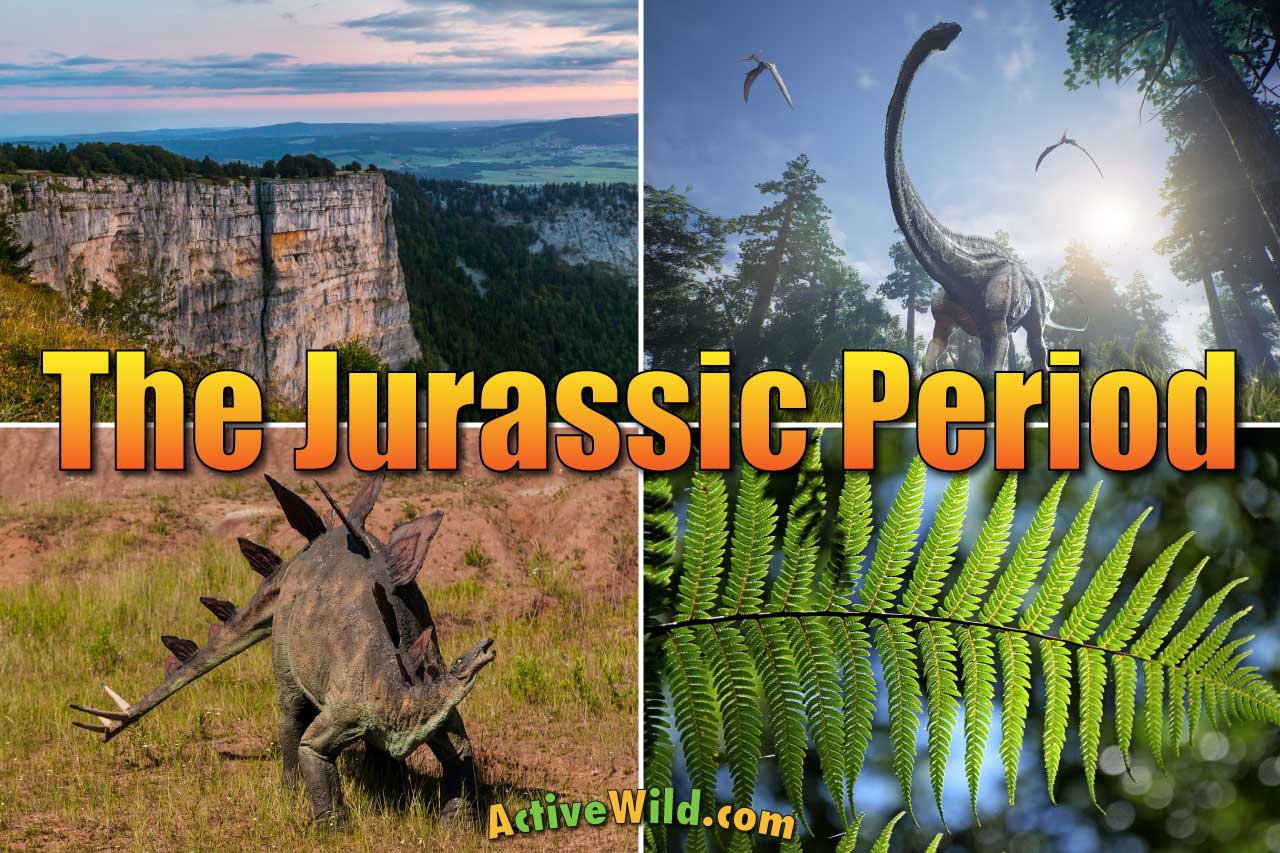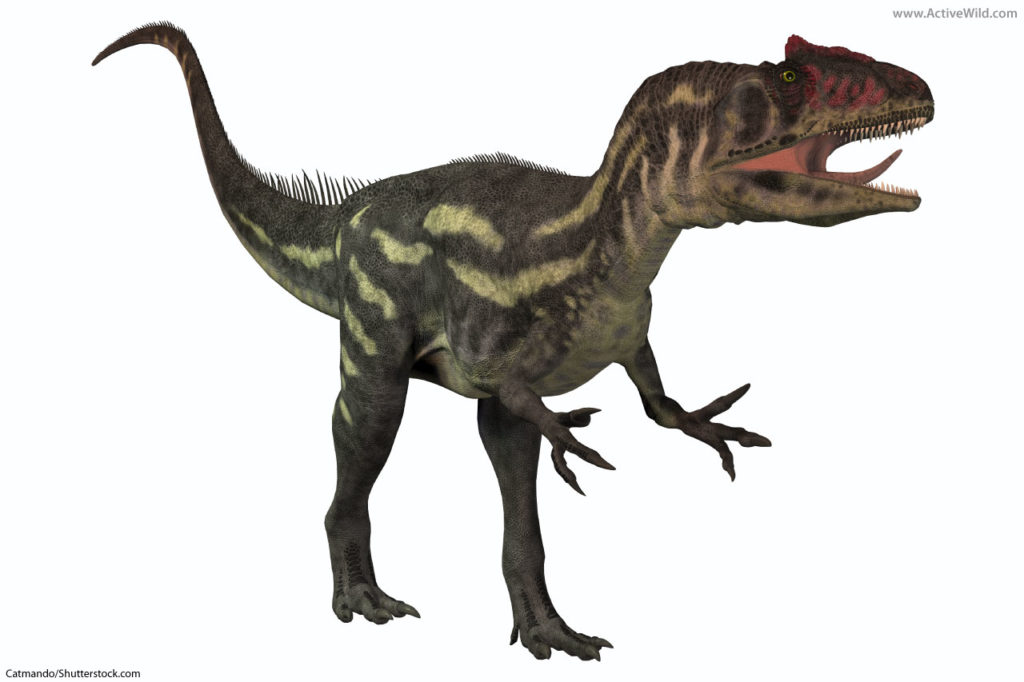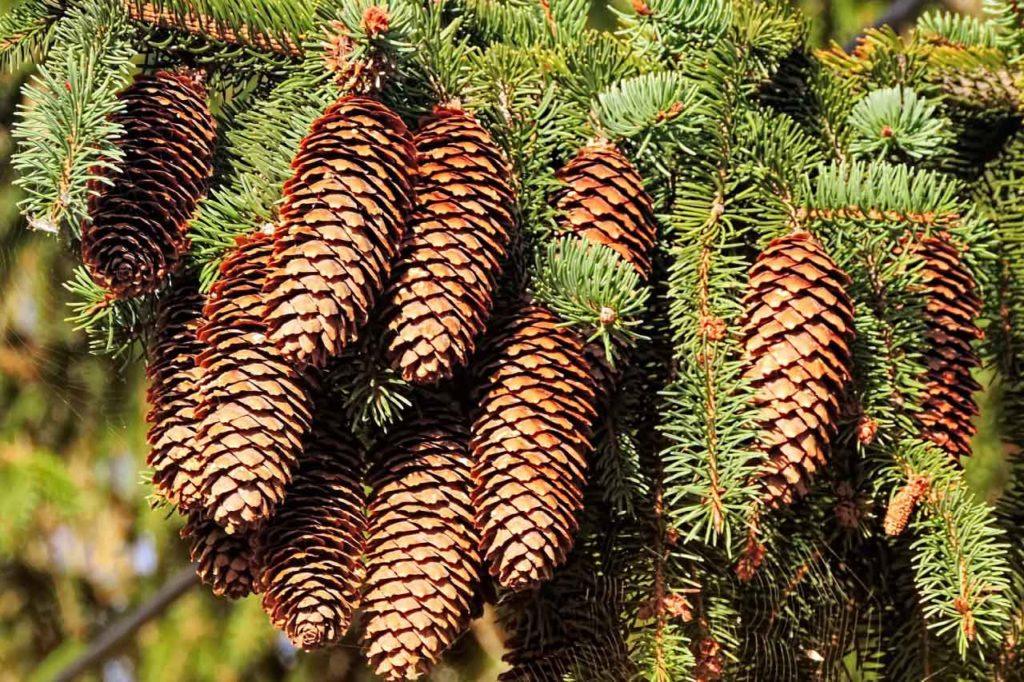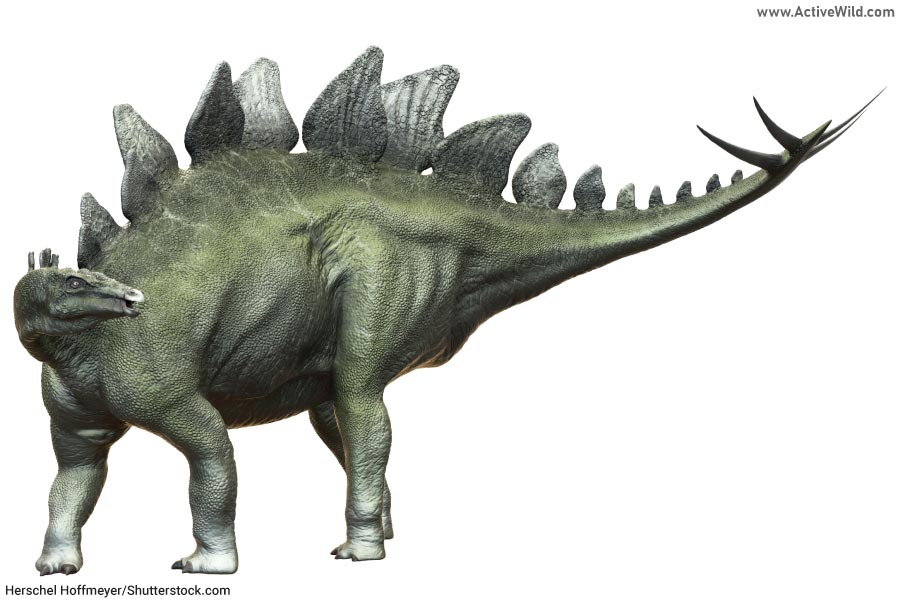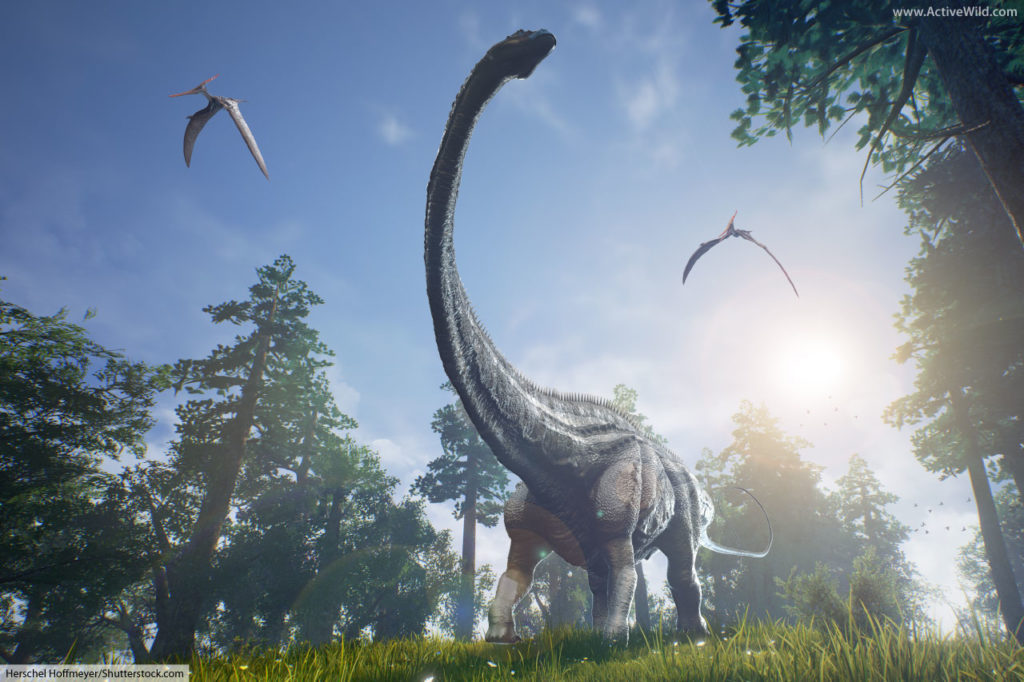The Jurassic Period facts for kids and adults. The ultimate guide to the second period of the Mesozoic Era.
Introduction
The Jurassic Period lasted for 56 million years, and was the second of the three periods of the Mesozoic Era.
During the Jurassic Period dinosaurs became the dominant animals on land. Controlling the skies were winged reptiles known as pterosaurs, and giant, predatory reptiles swam in the oceans: the Jurassic Period truly was a time in which the reptiles ruled Earth.
During the Jurassic Period Earth’s appearance changed dramatically, with the huge supercontinent Pangea splitting up into two landmasses: Laurasia in the north, and Gondwana (or Gondwanaland) in the south.
On this page we’ll travel millions of years back in time to explore the ever-changing world of the Jurassic Period…
Page Index
- Top Jurassic Period Facts
- The Jurassic Period And The Geologic Timescale
- Epochs of the Jurassic Period
- Earth during the Jurassic Period
- Jurassic Period Continents
- Triassic-Jurassic Extinction Event
- The Jurassic Period Climate
- Jurassic Period Plants
- Jurassic Period Animals
- Amphibians
- Reptiles
- Marine Reptiles
- Pterosaurs
- Mammals
- Birds
- Insects And Other Invertebrates
- Dinosaurs of the Jurassic Period
- Ornithischian Dinosaurs
- Saurischian Dinosaurs
- Theropods
- Conclusion & Further Reading
Discover More with Active Wild
- Jurassic Dinosaurs
- Jurassic Animals
- Triassic Period: The Ultimate Guide
- Cretaceous Period: The Ultimate Guide
- Main dinosaur page
- Dinosaur Books
- Dinosaur DVDs
- Dinosaur Toys & Gifts
Top Jurassic Period Facts
- The Jurassic Period is a period of time in the geologic time scale.
- It’s named after the Jura Mountain range on the France / Switzerland border.
- Rocks in this region were formed during the Jurassic Period.
- The Jurassic Period began 201.3 million years ago (Mya) and ended 145 Mya.
- It lasted 56 million years, and was the second-longest period of the Mesozoic Era.
- The Jurassic is the second of the three periods of the Mesozoic Era. It came after the Triassic Period and before the Cretaceous Period.
- During the Jurassic Period the supercontinent Pangea split apart into two smaller landmasses: Laurasia in the north, and Gondwana in the south.
- The climate during the Jurassic Period was warm and humid.
- The Jurassic Period was preceded by a mass extinction event (known as the Triassic – Jurassic extinction event) that saw 50% of all species become extinct.
- The Triassic-Jurassic extinction event killed off the dinosaurs’ main competitors, allowing the fearsome reptiles to seize control of the land.
- The dominant plant-eating dinosaurs of the Jurassic Period were the sauropods. These large, long-necked dinosaurs include familiar dinosaur types such as diplodocus, brachiosaurus and brontosaurus.
- A new group of plant-eating dinosaurs known as the ornithischians appeared in the Jurassic Period. One of the best known examples of a Jurassic ornithischian is the stegosaurus.
- In the oceans ichthyosaurs and plesiosaurs were the dominant predators.
- During the late Jurassic, the first true birds appeared.
- The period also saw the arrival of the first lizards, and the first butterflies.
Let’s ‘dig deeper’ into the real Jurassic world…
The Jurassic Period And The Geologic Timescale
The Jurassic Period is a period of the geologic time scale. It is the second of the three periods of the Mesozoic Era. It came after the Triassic Period, and before the Cretaceous Period.
The geologic time scale is a way of measuring Earth’s history using layers of rock in the ground. Each period in the geologic time scale corresponds to the time in Earth’s history during which a specific layer of rock was formed.
The Jurassic Period is named after the Jura Mountain range which lies on the France / Switzerland border. The period corresponds to the time in history in which layers of limestone present in this region were being formed.
The Jurassic Period itself is divided into three parts, called epochs. Each epoch corresponds to a layer of rock in the main Jurassic Layer.
Epochs of the Jurassic Period:
- Early Jurassic: 201.3 – 174.1 Mya
- Middle Jurassic: 174.1 – 163.5 Mya
- Late Jurassic: 163.5 – 145 Mya
Earth During The Jurassic Period
Jurassic Period Continents
During the Jurassic Period, the supercontinent Pangea began to split into the continents that we know today. The animation below shows the entire process, which continued throughout the Cretaceous period (and continues to this day).
At the beginning of the Jurassic Period, Earth looked a very different planet to the one it is today.
Instead of having different continents and oceans there was just one supercontinent, known as Pangea. Pangea was surrounded by a vast ocean known as Panthalassa, or the Panthalassic Ocean.
In the preceding Triassic Period, cracks had begun to form on Pangea. Unimaginably powerful forces beneath the ground were splitting the supercontinent apart.
During the early Jurassic Period Pangea finally broke apart, forming two supercontinents: Laurasia in the north, and Gondwana (or Gondwanaland) in the south.
Over the course of the Jurassic and into the following Cretaceous period, these two supercontinents would themselves begin to break up into smaller land masses. Laurasia would eventually become North America, Greenland, Europe and Asia.
Gondwana would split into two main parts: a western section, which would eventually become South America and Africa, and an eastern section containing Australia, India, Madagascar and Antarctica.
Sea levels rose during the Jurassic Period. This caused large areas of land to be covered with warm, shallow seas.
The newly-formed oceans meant that Jurassic animals were now confined to their own continents. This would have a dramatic effect on how different species were to evolve.
Triassic-Jurassic Extinction Event
At the end of the preceding Triassic Period, around 50% of all living species became extinct in what is known as the Triassic-Jurassic extinction event.
A period of intense volcanic activity–caused by the separation of Pangea–is thought to be responsible for the devastation.
Although not quite as catastrophic as the earlier Permian–Triassic extinction event (which is the worst known extinction event), the Triassic-Jurassic extinction event would have a long-lasting effect on life on Earth. In particular, it caused the extinction of nearly all of the pseudosuchians.
These fearsome reptiles had been the dominant land predators in the Triassic Period. Their disappearance paved the way for another reptile group to take charge in the Jurassic Period: the dinosaurs!
The Jurassic Period Climate
Whereas the Triassic Period was dry and hot, the Jurassic Period would become more humid, although temperatures were still very high. With more moisture in the air, more species were able to inhabit inland areas, which in the Triassic Period had been inhospitable deserts.
The high global temperature meant that there were no glaciers, and no polar ice caps (there probably wasn’t any land directly over either of the poles).
Jurassic Period Plants
It wasn’t just Jurassic animals that were continuing to evolve. Plants too were changing, branching into new orders, families and species.
The abundant plant life of the Jurassic Period included ferns, and gymnosperms (seed-producing plants that don’t produce fruit) such as ginkgoes, cycads and conifers. Mosses and liverworts too were present in the Jurassic Period, both having appeared millions of years before the Mesozoic Era began.
Bennettitales is a now-extinct order of tree-like seed plants that appeared in the Jurassic Period. Their flower-like reproductive parts may have given rise to the specialized mouth parts of insects.
However, it wouldn’t be until the Cretaceous Period that flowering plants would appear. There were therefore no grasses, and no flowering trees such as oaks and maples, in the Jurassic Period.
Jurassic Period Animals
Amphibians of the Jurassic Period
However, amphibians still played a part in Jurassic ecosystems. The earliest salamander fossils date back to the middle Jurassic period. Both frogs and caecilians were also present at this time.
Albanerpetontidae, a family of scaled, salamander-like amphibians, appeared in the Middle Jurassic.
Brachiopoids were amphibians in the order Temnospondyli. They had flat bodies and flat, shovel-shaped heads. Some grew to lengths of 2 to 3 m (6.5 to 10 ft.), and were fearsome predators.
Siderops was another temnospondyl. This 2.5 meter (9.2 ft.) long, crocodile-like Jurassic amphibian lived in what is now Australia.
Reptiles of the Jurassic Period
In the Triassic Period it had been the fearsome pseudosuchians – including the 7 m (23 ft.) saurosuchus – that had ruled the land.
However, most of the pseudosuchians became extinct in the end-Triassic extinction event. Only a handful of smaller, crocodile-like pseudosuchians survived. These aquatic reptiles included the ancestors of all modern crocodilians.
Some of these early crocodiles lived in the sea. Dakosaurus was one of several marine crocodiles that lived in the Late Jurassic period. It grew to over 4 m (13.12 ft.) and has been found in both Europe and in the Americas.
Another Jurassic marine crocodile was Metriorhynchus, specimens of which have been found in Western Europe.
The earliest turtles had appeared in the Triassic. The Jurassic Period saw the appearance of the two modern turtle branches: Cryptodira, members of which pull their necks back into the shell, and Pleurodira, whose necks move sideways when retracted.
The first lizards also appeared in the Early Jurassic. However, it wouldn’t be until the Cretaceous Period that a branch of lizards would evolve into the first snakes.
Jurassic Period Marine Reptiles
Ichthyosaurus is the best-known Ichthyosaur. It was a 3 meter long, dolphin-like predator, with big eyes, four flippers, a dorsal fin, and long jaws packed with teeth.
There were two main types of plesiosaur. Both propelled themselves through the water with four powerful flippers.
Plesiosaurs in the group Plesiosauroidea had extremely long necks and small heads. Plesiosaurus was the first plesiosaur to be named, and it gives its name to the whole group. It was around 3.5 meters (11 ft.) in length. It moved through the water with a ‘flying’ like motion of the flippers.
Plesiosaurs in the group Pliosauroidea had short necks and massive heads. Animals in this group are also known as pliosaurs.
Liopleurodon was a fearsome pliosaur that lived in the Middle Jurassic. The largest known specimens of this apex predator reach 6.4 meters (21 ft.) in length.
Pterosaurs of the Jurassic Period
The many pterosaur species that lived during the Jurassic could be divided into two main types: Rhamphorhynchoidea and Pterodactyloidea.
The rhamphorhynchoids appeared in the Late Triassic Period, and were the first pterosaurs. They had long tails and teeth. Although abundant at the beginning of the Jurassic Period, most would be extinct by the start of the Cretaceous Period.
Rhamphorhynchus was a rhamphorhynchoid pterosaur that lived in the Late Jurassic. Its wingspan reached 1.81 m (5.9 ft.), and at the end of its long tail was a diamond-shaped paddle.
The pterodactyloids branched off from the rhamphorhynchoids in the Late Jurassic. They had short tails, and those present at the end of the Jurassic Period lacked teeth. Many pterodactyloids had crests.
Pterodactylus was a member of the Pterodactyloidea, and was the first pterosaur to be identified. It lived during the Late Jurassic Period and had a wingspan of just over 1 m (3.3 ft.).
Jurassic Period Mammals
The early mammals that had appeared in the Late Triassic continued becoming ever more ‘mammal-like’ in the Jurassic Period.
The Late Jurassic saw the appearance of the first Therian mammals. These animals, which included the ancestors of all of today’s mammals (except for the egg-laying monotremes) gave birth to live young, rather than laying eggs.
The Therians began to split into two main branches in the late Jurassic. One branch included the ancestors of the placental mammals (Eutheria); the other included the ancestors of the marsupials (Metatheria).
Most Jurassic mammals were small, shrew-like animals. Juramaia was one such animal. An early ancestor of the placental mammals, it grew to lengths of 10 cm and lived in China.
Although most early mammals were thought to have lived on the ground, Juramaia’s forelimbs appear to have been adapted to climbing, suggesting that it may have spent at least some of its life in the trees.
Birds of the Jurassic Period
The first birds appeared around 150 Mya, during the Late Jurassic. They evolved from feathered, bird-like theropod dinosaurs. Today, most scientists regard birds as being the only surviving dinosaurs.
Archaeopteryx is a well-known bird-like dinosaur that lived in the Late Jurassic. Although it had wings like a modern bird, it also possessed teeth, clawed fingers and a long tail – features that modern birds have lost.
Archaeopteryx is seen as the ‘missing link’ between dinosaurs and birds, but may actually have just been a relative of the dinosaurs that would eventually become birds.
Insects And Other Invertebrates of the Jurassic Period
Insects had first appeared over 200 million years before the Jurassic Period, in the Devonian Period of the Paleozoic Era (if not before). However, they were continuously evolving and the Jurassic Period saw the appearance of several new groups. The best known of these new insect groups is the order Lepidoptera – the butterflies and moths.
Other insect groups that appeared in the Jurassic Period include the snakeflies (order Raphidioptera) and the mantidflies in the family Mantispidae.
Crustaceans had appeared many millions of years before the Jurassic Period, but it was only in the Jurassic Period that the first crabs and shrimps would appear.
Dinosaurs of the Jurassic Period
With their archosaur rivals out of the way, it was the turn of the dinosaurs to thrive in the Jurassic Period.
The two main lines of dinosaurs – the ‘bird-hipped’ ornithischians and the ‘lizard-hipped’ saurischians – both took advantage of the favorable conditions, giving rise to many new species.
Ornithischian Dinosaurs Of The Jurassic Period
One of the earliest ornithischians was Lesothosaurus. It was a 2 m (6.56 ft.) long plant eater that walked on two legs. It was found in southern Africa.
A group of ornithischians known as ornithopods appeared in the Middle Jurassic. These plant-eating dinosaurs were widespread, but not as prolific as the saurischian plant-eaters. However, during the course of the Mesozoic Era they would continue to develop, finally becoming the dominant plant-eaters in the Cretaceous Period.
Thyreophora, a group of ornithischian dinosaurs also known as the ‘armored dinosaurs’ first appeared in the early Jurassic. Their best-known representative in the Jurassic Period was stegosaurus.
Saurischian Dinosaurs Of The Jurassic Period
Some of the Jurassic Period’s best-known dinosaurs were sauropods. Sauropods were plant-eating saurischian dinosaurs. They had extremely long necks and tails, and walked on four tree-trunk-like legs. They first appeared in the Triassic Period, but became widespread during the Jurassic Period.
Well-known Jurassic sauropods include the diplodocus, brachiosaurus and brontosaurus.
Theropods
The dominant land predators of the Jurassic Period were theropods. Coelophysidae, a family of small theropods, first appeared in the Triassic Period. They were the main predators of the early Jurassic.
As the Jurassic Period progressed, many other predatory theropods would appear. These included larger meat-eaters such as the Allosaurus, an 8.5 m (28 ft.) (or larger) apex predator that lived in what is now North America.
The Jurassic Period: Conclusion & Further Reading
We hope that you have enjoyed this exploration of the Jurassic Period.
You'll find more amazing prehistoric information in the following pages:
- Triassic Period: The Ultimate Guide
- Cretaceous Period: The Ultimate Guide
- Dinosaur Books
- Dinosaur DVDs
- Dinosaur Toys & Gifts
- Dinosaur Facts: Main Page
- List of Dinosaurs with Pictures and Information
- Dinosaur Periods of the Mesozoic Era
- Types of Dinosaurs
- Why did Dinosaurs Become Extinct?
- When were Dinosaurs Alive?
- How Long Were Dinosaurs On Earth?
- Animals That Lived With Dinosaurs
- List Of Prehistoric Animals That Are Not Dinosaurs
- When Did Dinosaurs Go Extinct?
- How Big Was the Asteroid That Killed the Dinosaurs?
- What is the Smallest Dinosaur?
- Are Dinosaurs Reptiles?
- Were Dinosaurs Real?
- When Were Dinosaurs Discovered?
- How Long Ago Did Dinosaurs Live?

